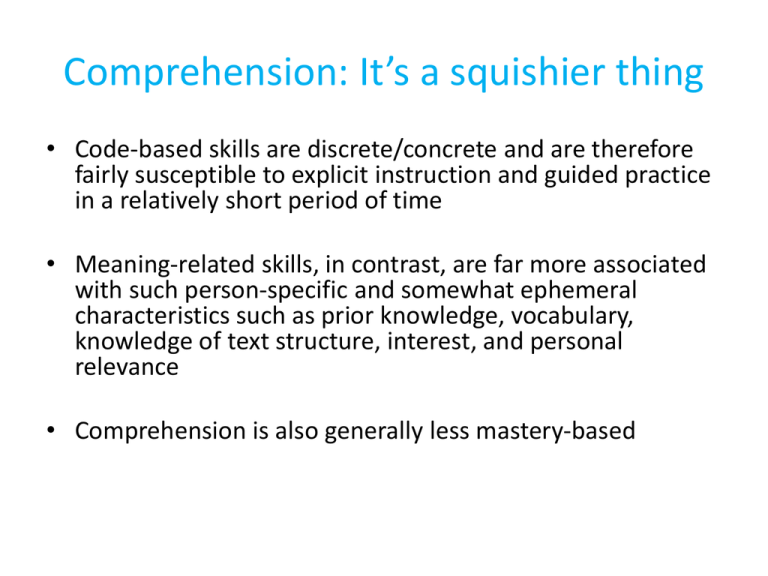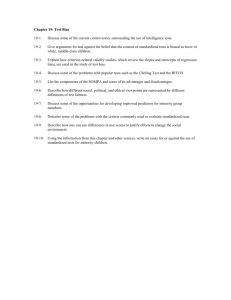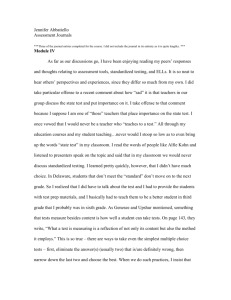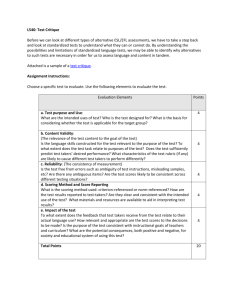ELL & LD
advertisement

Comprehension: It’s a squishier thing • Code-based skills are discrete/concrete and are therefore fairly susceptible to explicit instruction and guided practice in a relatively short period of time • Meaning-related skills, in contrast, are far more associated with such person-specific and somewhat ephemeral characteristics such as prior knowledge, vocabulary, knowledge of text structure, interest, and personal relevance • Comprehension is also generally less mastery-based Determination of English Language Proficiency 1. Proficiency Interview (or ‘Home Language Survey’) * What language did the child first learn to speak? * What language does he/she speak best now? * How many years has he/she been exposed to spoken and written English? * What language is spoken the most by individuals in the home? * What language does the child speak at home most of the time? 2. Standardized English Language Proficiency Test * WIDA Access Test (‘ACCESS for ELLs’) * LAS (Language Assessment Scales) WIDA ACCESS Test • ACCESS for ELLs® is a large-scale test used to assess English language proficiency (ELP). It does not assess content area knowledge such as math or social studies. Four language domains are assessed: listening, speaking, reading, and writing. ACCESS for ELLs® composite scores are used to assign an ELP level as indicated: ELP Level Level 1 Level 2 Level 3 Level 4 Level 5 Level 6 Descriptio n Entering Beginning Developin g Expanding Bridging Reaching Composit 1.0 - 1.9 2.0 - 2.9 3.0 - 3.9 4.0 - 4.9 5.0 - 5.9 6 How long does it take ELL kids to develop reasonable English proficiency? • Oral language: 3 – 5 years • Academic English: 4 – 10 years • There is great variability in how quickly ELL students learn English and in the type of proficiency they reach in conversational and literacy situations. Hahta, Butler and Witt, 2000 (Stanford University Study) Federal Definition of SLD Specific learning disability means a disorder in one or more of the basic psychological processes involved in understanding or in using language, spoken or written, that may manifest itself in an imperfect ability to listen, think, speak, read, write, spell, or to do mathematical calculations, including conditions such as perceptual disabilities, brain injury, minimal brain dysfunction, dyslexia, and developmental aphasia. Specific learning disability does not include learning problems that are primarily the result of visual, hearing, or motor disabilities, of mental retardation, of emotional disturbance, or of environmental, cultural, or economic disadvantage. From the Maine Sped Regs (Chapter 101) Assessments and other evaluation materials used to assess a child under this section . . (a) Are selected and administered so as not to be discriminatory on a racial or cultural basis; (b) Are provided and administered in the child’s native language or other mode of communication and form most likely to yield accurate information on what the child knows and can do academically, developmentally, and functionally, unless it is not feasible to so provide or administer; (c) Are used for purposes for which the assessments or measures are valid and reliable. Page 44 More Chapter 101 The child scores 1.5 or more standard deviations below the mean for the child ’s age on tests in one area of psychological processing, or 1 or more standard deviations below the mean in two or more areas of psychological processing. Instruments used for determining processing disorders must have peer reviewed, scientific research documentation, independent of that provided in the test manual, that supports a correlation between the processing problem and the academic deficit; Such tests may include measures of memory, phonological skills, processing speed as well as other measures which explicitly test psychological processing. Page 80 The reality . . • There are NO cognitive processing measures that are standardized on English Language Learners(non-native English speakers). • That means that there are NO standardized tests of processing that can be considered reliable and valid for use with ELL kids. Chapter 101 For children in grades 4-12, the following criteria must also be met: The child obtains a composite standardized score that is no lower than 1.5 standard deviations below the mean on at least one index/scale of cognitive functioning from a standardized measure of general cognitive ability. The index/scale must include at least 3 subtests and the score must be interpretable according to the test used. Page 80 The reality . . • There are a few nonverbal intellectual assessment measures that are standardized on some ELL populations: 1. Universal Nonverbal Intelligence Test (UNIT) 2. Wechsler Nonverbal Scale of Ability (WNS) 3. Kaufman Assessment Battery for Children, Second Edition (KABC-2) 4. Differential Abilities Scale, 2nd Edition But none of these are standardized on African and Asian populations for the purpose of identifying cognitive processing disorders. The Bottom Line: The standardized assessment of cognitive processing disorders can only be done with native English speakers. It simply cannot be fairly (ethically, reliably, validly) done with ELL/non-native English speakers. Some consolation . . We can use any instruments we want to in a NONSTANDARDIZED manner. Chapter 101 The child does not achieve adequately for the child’s age or to meet State-approved grade-level standards in one or more of the following areas, when provided with learning experiences and instruction appropriate for the child’s age or State-approved grade-level standards: (aa) (bb) (cc) (dd) (ee) (ff) (gg) (hh) Oral expression. Listening comprehension. Written expression. Basic reading skill. Reading fluency skills. Reading comprehension. Mathematics calculation. Mathematics problem solving. Page 81 The reality . . • There are NO standardized/individualized measures of academic achievement that have been standardized on ELL/non-native English speakers. • The WIAT-III and KTEA-2 manuals explicitly state that non-native English speaking populations were purposefully excluded from the standardization sample/population. If the WIAT-III or similar instruments are used with ELL kids: • Only raw score derived scores (e.g., age and grade equivalent scores) should be computed • Since these scores provide an indication of the amount of English-based academic skill a student has amassed in his/her time in this country (not from a standardized perspective, but simply from a ‘how much has the kid learned?’ perspective). Chapter 101 The child does not make sufficient progress to meet age or State approved grade-level standards in one or more of the areas identified in paragraph (i)(I) of this section when using a process based on the child’s response to scientific, research-based intervention; or the child exhibits a pattern of strengths and weaknesses in performance, achievement, or both, relative to age, State-approved grade level standards, or intellectual development, that is determined by the group to be relevant to the identification of a specific learning disability, using appropriate assessments, consistent with §§300.304 and 300.305[Section V]. Page 81 Even More Maine Sped Regs: The group determines that its findings under paragraphs (i)(I) and (II) of this section are not primarily the result of— (aa) A visual, hearing, or motor disability; (bb) Mental retardation (now known as intellectual disability); (cc) Emotional disturbance; (dd) Cultural factors; (ee) Environmental or economic disadvantage; or (ff) Limited English proficiency. Page 83 The most sane/reasonable way forward with regard to SLD assessment of ELL kids: • Assessment methods that avoid the use of standardized intellectual, processing, and academic achievement methods and that instead center on . . • Response to intervention/multi-tiered problem-solving based approaches (i.e., Minneapolis’ SNAP model – Student in Need of Alternative Programming) It’s a S.N.A.P. The Minneapolis problem-solving model (MPSM) is a problem-solving model that includes collaborative consultation. It is designed as a three-tier process to measure Response to Intervention (RTI) and is used in the special education eligibility process. Marston, Muyskens, Lau, and Canter (2003) identified four themes driving district implementation: 1. The inappropriateness of intelligence tests and the IQ– achievement discrepancy for determination of eligibility; 2. Bias in assessment; 3. Allocation of school psychologist time; 4. Linking assessment to instruction through curriculumbased measurement (CBM). RTI Network More on the Minneapolis Model Within this model, intervention assistance teams (IATs) are responsible for problem solving and consist of the general education teacher, special education personnel, the school psychologist, and other specialists and administrators as needed. The IATs use a four-step system for identifying and supporting students with academic difficulties: a) describing with specificity the student’s problem, b) generating and implementing strategies for instructional intervention, c) monitoring student progress and evaluating effectiveness of instruction, and d) continuing this cycle as necessary. RTI Network (rtinetwork.org) Not ‘SLD,’ but SNAP Students found eligible for special education services under this alternative model are identified on their IEP’s as ‘S.N.A.P.’ That is, as a Student in Need of Alternative Programming (it’s essentially a non-categorical classification). What is it??? AIMSweb is a benchmark and progress monitoring system based on direct, frequent and continuous student assessment. The results are reported to students, parents, teachers and administrators via a web-based data management and reporting system to determine response to intervention. Sped eligibility and progress monitoring Small group progress monitoring Universal benchmarking CBM data informs the eval process





